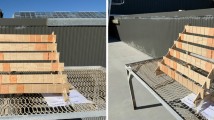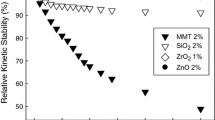Abstract
Aqueous dispersions of copper-carbonate nanoparticles and microparticles have just begun to be exploited commercially for the preservative treatment of wood. The success of the new systems will depend, in part, on the uniform distribution of the preservative in wood and the ability of copper to penetrate cell walls. We examined the distribution of copper in wood treated with a nano-Cu preservative. Copper particles are not uniformly distributed in treated wood, but they accumulate in voids that act as the flow paths for liquids in wood. Particles are deposited on, but not within cell walls. Nevertheless, elemental copper is present within cell walls, but at a lower level than that in wood treated with a conventional wood preservative. These findings suggest that nano-Cu preservatives are able to deliver bioactive components into wood cell walls even though the majority of copper particles are too large to penetrate the cell wall’s nanocapillary network.









Similar content being viewed by others
References
Arsenault RD (1973) Factors influencing the effectiveness of preservative systems. In: Nicholas DD (ed) Wood deterioration and its prevention by preservative treatments, vol 2. Syracuse University Press, New York, pp 121–278
Borm P, Klaessig FC, Landry TD, Moudgil B, Pauluhn J, Thomas K et al (2006) Research strategies of nanomaterials, Part V: Role of dissolution in biological fate and effects of nanoscale particles. Toxicol Sci 90:23–31. doi:10.1093/toxsci/kfj084
Cao J, Kamdem KD (2005) Microdistribution of copper in copper-ethanolamine (Cu-EA) treated southern yellow pine (Pinus spp.) related to density distribution. Holzforschung 59:82–89. doi:10.1515/HF.2005.013
Chen R, Chen D, Li H (2006) Wood preservative containing copper and ammonium compounds. Chinese Patent 1883899, 10 pp
Chou CK, Chandlar JA, Preston RD, Ayer R (1973) Microdistribution of metal elements in wood impregnated with a copper-chrome-arsenic preservative as determined by analytical electron microscopy. Wood Sci Technol 7:151–160. doi:10.1007/BF00351157
Colvin VL (2003) The potential environmental impact of engineered nanomaterials. Nat Biotechnol 21:1166–1170. doi:10.1038/nbt875
Drysdale JA, Dickinson DJ, Levy JF (1980) Microdistribution of a CCA preservative in five timbers of varying susceptibility to soft rot. Mater Organismen 15(4):287–303
Evans PD (2003) Emerging technologies in wood protection. Forest Prod J 53(1):14–22
Flournoy DS, Kirk TK, Highley TL (1991) Wood decay by brown-rot fungi: changes in pore structure and cell wall volume. Holzforschung 45:383–388
Fujino T, Itoh T (1998) Changes in the three dimensional architecture of the cell wall during lignification of xylem cells in Eucalyptus tereticornis. Holzforschung 52:111–116
Genstat (2000) Genstat for Windows. Release 4.3, 5th edn. VSN International Ltd, Oxford
Goldstein JI, Newbury DE, Joy DC, Lyman CE, Echlin P, Lifshin E et al (2003) Scanning electron microscopy and X-ray microanalysis. Plenum Publishers, New York
Greaves H (1974) The microdistribution of copper-chrome-arsenic in preservative treated sapwood using X-ray microanalysis in scanning electron microscopy. Holzforschung 28:193–200
Grethlein HE (1985) The effect of pore size distribution on the rate of enzymatic hydrolysis of cellulosic substrates. Biotechnology 3:155–160
Haraguchi H (1992) Fundamentals and applications of ICP atomic-emission spectrometry. Kodan-sha Publishers, Tokyo
Hulme MA, Butcher JA (1977) Soft-rot control in hardwoods treated with chromated copper arsenate preservatives. I. Treatment problems. Mater Organismen 12:81–95
Kasahara H, Suzuki T, Tsuruhara T (1999) Morphological observation of the cysts of Acanthamoeba spp using a low-vacuum SEM. Bull Tokyo Gakugei Univ Sect 4 51:15–22
Kerr AJ, Goring DAI (1975) The role of hemicellulose in the delignification of wood. Can J Chem 53:952–959. doi:10.1139/v75-134
Leach RM, Zhang J (2004) Micronized wood preservative formulations comprising metal compounds and organic biocides. World Patent 2004091875, 32 pp
Leach RM, Zhang J (2005) Micronized wood preservative formulation. World Patent 2005104841, 26 pp
Martišius T, Giraitis R (2006) Diffusion of copper ions into kaolinite layers. J Eur Ceram Soc 26:1653–1661. doi:10.1016/j.jeurceramsoc.2005.04.025
Matsugo S, Minami S, Ito K, Kasahara H, Tsuruhara T (1999) The elemental analysis of ostiole of Acanthamoeba spp by low-vacuum SEM. Jpn J Protozool 32:33
Matsunaga H, Noguchi A, Matsumura J, Oda K (2000) Distribution of inorganic elements in wood impregnated with preservative solutions (part 1): visualization of inorganic element distribution in wood by SEM-EDXA. Mokuzai Gakkaishi 46:368–374
Matsunaga H, Matsumura J, Oda K (2001) Distribution of inorganic elements in wood impregnated with preservative solutions (part 2): effect of anatomical characteristics on microdistribution of preservatives in Cryptomeria japonica sapwood. Mokuzai Gakkaishi 47:383–388
Matsunaga H, Matsumura J, Oda K, Takechi Y (2002) Microdistribution of copper in Cryptomeria japonica sapwood treated with CuAz preservative. Mokuzai Gakkaishi 48:199–206
Matsunaga H, Matsumura J, Oda K (2004) X-ray microanalysis using thin sections of preservative-treated wood: relationship of wood anatomical features to the distribution of copper. IAWA J 25:79–90
Nicholas DD, Siau JF (1973) Factors influencing the treatability of wood. In: Nicholas DD (ed) Wood deterioration and its prevention by preservative treatments, vol 2. Syracuse University Press, New York, pp 299–343
Ohgoshi M, Nakato K, Sadoh T (1982a) Quantitative evaluation of bordered-pit membrane pores of softwoods by the image-analysis system. Mokuzai Gakkaishi 28:583–589
Ohgoshi M, Nakato K, Sadoh T (1982b) Contribution of bordered-pit membrane pores to flow through softwoods. Mokuzai Gakkaishi 28:590–595
Petrič M, Murphy RJ, Morris I (2000) Microdistribution of some copper and zinc containing waterborne and organic solvent wood preservative in spruce wood cell walls. Holzforschung 54:23–26. doi:10.1515/HF.2000.004
Petty JA (1970) Permeability and structure of the wood of sitka spruce. Proc R Soc Lond B Biol Sci 175:149–166
Petty JA, Preston RD (1968) Electron probe microanalysis of metals in cell walls of conifer wood treated with preservatives. Holzforschung 22:174–177
Preston AF (2000) Wood preservation: trends of today that will influence the industry tomorrow. Forest Prod J 50:12–19
Preston A, Jin L, Nicholas D, Zahora A, Walcheski P, Archer K, Schultz T. (2008) Field stake tests with copper-based preservatives. Int. Res. Group on Wood Pres. Doc. IRG/WP 08–30459
Rudman P (1966) Studies in wood preservation. III The penetration of the fine structure of wood by inorganic solutions, including wood preservatives. Holzforschung 20:60–67
Siau JF (1984) Transport processes in wood. Springer-Verlag, Berlin
Stirling R, Drummond J, Zhang J, Ziobro RJ (2008) Micro-distribution of micronized copper in southern pine. Int. Res. Group on Wood Pres. Doc. IRG/WP 08–30479
Stone JE, Scallan AM (1968) The effect of component removal upon the porous structure of the cell wall of wood Part III. A comparison between the sulphite and kraft processes. Pulp Paper Mag Can 69:288–293
Suzuki T, Toda T (1996) Low vacuum SEM and its application to plankton observation. Jeol News 32E:31–34
Suzuki T, Shibata M, Tanaka K, Tuchida K, Toda T (1995) A new drying method: low-vacuum SEM freeze drying and its application to plankton observation. Bull Plankton Soc Jpn 42:53–62
Suzuki J, Murata I, Murata R, Morozumi S, Suzuki T (1998) A method for identification of Cryptosporidium paravum from river water using low-vacuum SEM. Jpn J Food Microbiol 14:187–191
Tarkow H, Feist WC, Southerland CF (1966) Interaction of wood with polymeric materials. Penetration versus molecular size. Forest Prod J 16:61–65
Vlosky RP (2006) Statistical overview of the U.S. wood preserving industry: 2004. Southern Forest Products Assoc, Kenner, Louisiana
Waldron L, Cooper PA, Ung TY (2005) Prediction of long-term leaching potential of preservative-treated wood by diffusion modeling. Holzforschung 59:581–588. doi:10.1515/HF.2005.095
Wardrop AB, Davies GW (1961) Morphological factors relating to the penetration of liquids into wood. Holzforschung 15:129–141
Xia X, Xie C, Cai S, Yang Z, Yang X (2006) Corrosion characteristics of copper microparticles and copper nanoparticles in distilled water. Corros Sci 48:3924–3932. doi:10.1016/j.corsci.2006.04.007
Zhang J, Kamdem PD (2000) FTIR characterization of copper ethanolamine—wood interaction for wood preservation. Holzforschung 54:119–122. doi:10.1515/HF.2000.020
Acknowledgements
The authors gratefully acknowledge the expert technical assistance of Derrick Horne (BioImaging Facility, UBC) and Bill Roth (Hitachi High Technologies America, Pleasanton, CA). We are very grateful for the financial support for this research provided by The OECD (Award of a Co-operative Research Program Fellowship to HM), Canadian Foundation for Innovation, BC Knowledge Development Fund and Ministry of Education, Culture, Sports, Science and Technology of Japan (Grant-in-Aid for Scientific Research no. 19780138). We would like to thank Dr. Kazuyuki Oda and Dr. Junji Matsumura for their suggestions and Dr. Yuko Ito for ICP analysis.
Author information
Authors and Affiliations
Corresponding author
Rights and permissions
About this article
Cite this article
Matsunaga, H., Kiguchi, M. & Evans, P.D. Microdistribution of copper-carbonate and iron oxide nanoparticles in treated wood. J Nanopart Res 11, 1087–1098 (2009). https://doi.org/10.1007/s11051-008-9512-y
Received:
Accepted:
Published:
Issue Date:
DOI: https://doi.org/10.1007/s11051-008-9512-y




